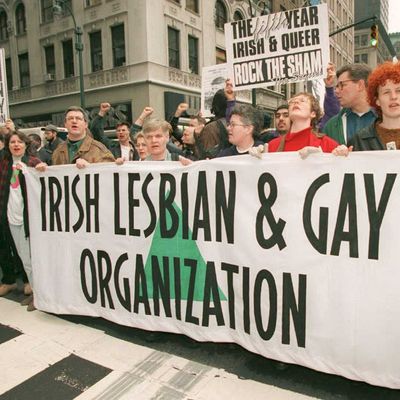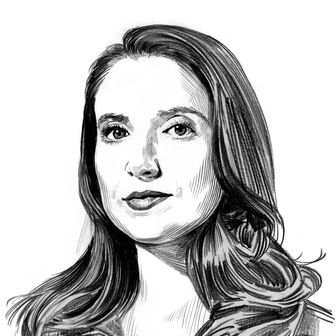
When green-clad school kids, city workers, and bagpipers head down Fifth Avenue on Monday, the St. Patrick’s Day parade will not include the mayor for the first time in two decades. Mayor de Blasio is boycotting it because participants are not allowed to identify themselves as gay. Controversy has always surrounded the parade (in the past there were skirmishes over allowing women to be grand marshal and even letting children in wheelchairs take part), but the fight over including gays is the longest and most bitter. While many who line the route will be too young to remember it, the debate over allowing gays to march dates back to 1991, when New York’s last Democratic mayor was in office.
When the Irish Lesbian and Gay Organization (ILGO) asked to join the parade in late 1990, their request was denied, but the organizers insisted it had nothing to do with the belief that homosexuality and Irish Catholicism don’t mix. The Ancient Order of Hibernians, which has run the 252-year-old parade since about 1851, argued that it wouldn’t be fair to let gay groups march, claiming that 30 organizations were already waiting for admittance to an event that the city wanted to reduce in scale. But when the Irish Lesbian and Gay Organization asked to see the waiting list, the organizers refused.
Mayor David Dinkins stepped in and brokered a compromise: The 135 members of ILGO would be the guests of the Midtown chapter of the Ancient Order of Hibernians, and the mayor would march by their side. In return, the group would agree not to carry their own banner, and to abide by the parade rule banning marchers from wearing anything identifying themselves as a group. The New York Times headline declared, “Parade Furor Is Settled; Gay Group Will March.”
Dinkins joined ILGO in the parade the next day, but the “furor” was just beginning. As shown in the disturbing video below, the group was booed throughout the parade, and at one point, two beer cans were thrown at the mayor. “It was like marching in Birmingham, Alabama” during the civil rights movement, Dinkins told the Times. “I knew there would be deep emotions, but I did not anticipate the cowards in the crowd.”
In addition to boycotting the parade for the remainder of his term, Dinkins became embroiled in a legal battle with the Ancient Order of Hibernians. First, the mayor transferred the parade permit to the group’s New York State chapter, only to learn that they too planned to ban the ILGO for their allegedly “outrageous behavior and conduct” in 1991 (witnesses suggested they were mainly responding to abuse from the crowd).
In October 1992, the New York City Human Rights Commission ruled that the parade was secular, not religious, and said ILGO must be included. Citing the decision, in 1993, the city awarded the permit to the St. Patrick’s Day Parade Committee, which was comprised of Dinkins allies. According to the Times, they withdrew after the Ancient Order of Hibernians and its allies threatened to boycott the parade.
It appeared that there might not be a parade in 1993, but in late February, a federal judge gave the permit back to the Hibernians, calling the previous ruling “patently unconstitutional” because it violated the order’s free-speech rights. The legal fight was resolved in 1995 when the Supreme Court ruled unanimously that parade organizers in Boston had the right to exclude homosexuals.
Protests by LGBT groups became an annual tradition, and each year, city officials face an uncomfortable decision about how they’ll celebrate St. Patrick’s Day. Mayor Giuliani regularly marched in the parade, and in 2000, he was joined by Hillary Clinton, his opponent in New York’s Senate race. Her decision to march angered gays and lesbians, and the next year the freshman senator happened to have a scheduling conflict.
Mayor Bloomberg said he disagreed with the organizers and skipped the parade when he was running for office in 2001, but never missed the event as mayor – even after former City Council Speaker Christine Quinn, who is gay, began boycotting the event. “I feel very strongly these parades should be open to everyone,” he told the Daily News in 2011. “My job as mayor, nevertheless, is to attend these parades, and I will continue to attend them, at the same time, while I am working as hard as I can to get the parade organizers to change.”
Before his first parade, Bloomberg’s press secretary explained that he believes “the best way to change an organization is to do so from within.” Obviously, that didn’t work out so well, so it will be interesting to see if de Blasio’s strategy is more successful.






























